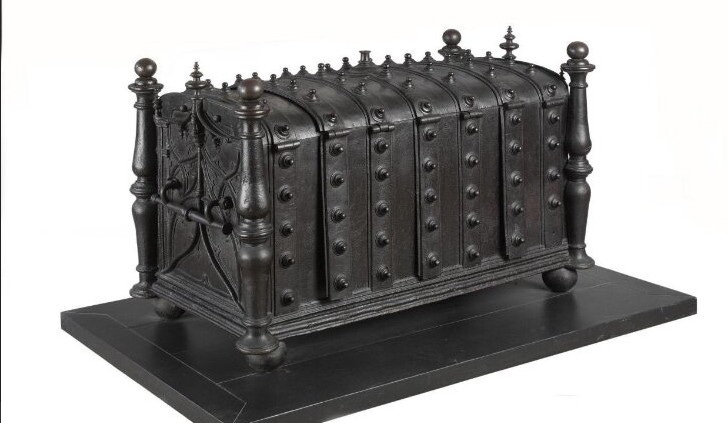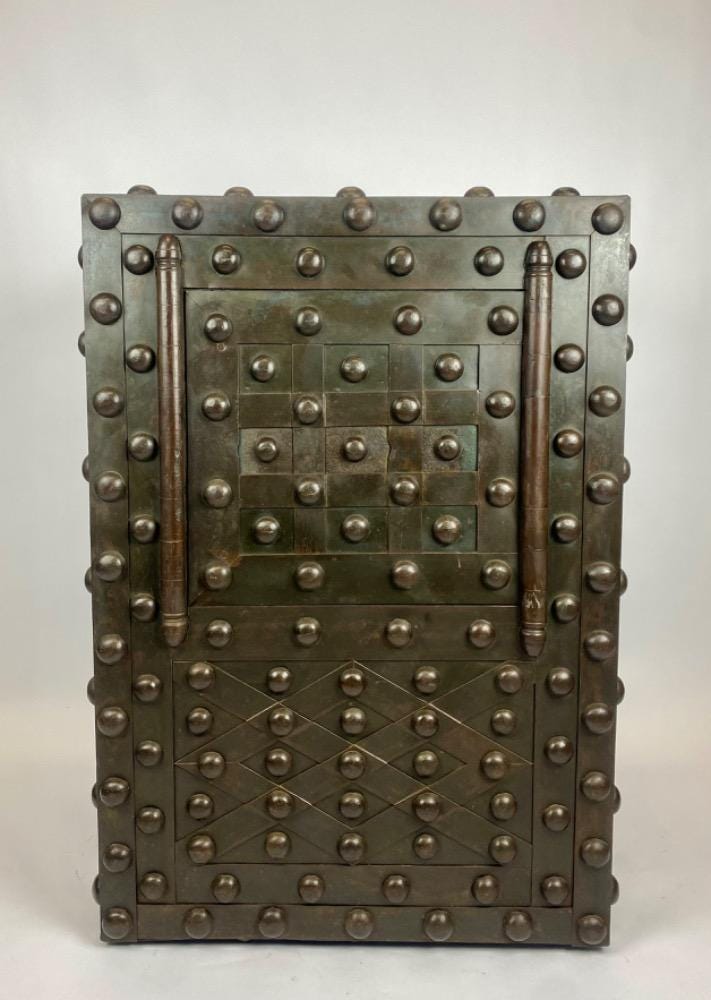How Safe is your Safe? Security Scandals of the Victorian Era
Alison Lloyd's newsletter #54
Let me drag you down cobblestone alleys in the midnight hours, into the devious Victorian world of burglary and break ins. We’re not talking Oliver Twist pick-pocketing here. No. This newsletter looks at the history of state-of-the-art security. And heist hi-jinks worthy of Sherlock Holmes.
I’m currently writing a historical novel set mostly in a jewellery shop. Biographies of pre-twentieth century jewellers are hard to find, so I turned to newspapers in my research. Jewellers advertised in nineteenth century newspapers like everyone else. But they appear occasionally in the news columns too. Here’s one story local to me:
A case of shop-breaking of a daring character is reported to have occurred at South Richmond early this morning. About a quarter to five o'clock Mr W. Wookey, who keeps a jewellery and tobacconist establishment at 338 Church Street, was awakened by hearing a loud crash. He was in bed at the time, and at once ran down to the front of his shop… The wooden shutters had been broken away by a jemmy, and [the plate-glass] had evidently taken a heavy blow to break. There was not the slightest trace of anyone about, but… jewellery of a very miscellaneous description, including a gold and several silver watches, and a number of Alberts, with brooches, bangles, etc., to the value of about £30, had been removed. Several watch chains were strewn over the footpath, and from the general appearance of the place it seemed that the robbers must have made very hasty disappearance…
The Herald, Melbourne, 23 September 1889
That was a pretty crude smash-and-grab. It has faded into obscurity, unlike the great train robbery of 1855. In that year £12,000 worth of gold bars were lifted from inside their safes, while travelling between London and Paris. The 1855 robbery was made into a movie starring Sean Connery in 1978. You can probably find it online somewhere to watch, so I won’t spoil the story for you.
Evidently Mr Wookey, and my fictional jeweller, needed better security. So what was available in the Victorian era? I discovered that the nineteenth century was the heyday of security inventions. They were very busy, the Victorians.
A Quick Pre-Industrial Recap
Once upon a time, from the Iron Age onwards, households rich enough to own valuables kept them in hefty chests like this:

As the European banking system developed, so too did the security measures used in the Western world. This is a locksmith’s model from eighteenth century France, used to demonstrate their strong room technology to potential customers.

But private individuals, and smaller businesses, needed a more compact way of securing their goods. So the hefty chests turned into even more solid safes. This hobnail safe is designed so it can’t be drilled or blasted open. It looks tough as old boots. Yet it also has a stylish air of mysterious impenetrability. It would look great in a heist movie.

Brute strength won’t break it. But know-how will.
The Great Safe Stand-Off
The Great Exhibition of 1851, held in the Crystal Palace, London, showcased the best in industrial design. The company founded by Joseph Bramah, (inventor of flush toilets and the fire hose), exhibited his ‘safety lock’, which had been unvanquished for 70 years. Chubb and Sons brought their innovative ‘detector lock’. This lock jammed up when tampered with. An advertisement printed beside the original instalments of Charles Dickens’ Bleak House read:
My name is Chubb, that makes the Patent Locks; Look on my works, ye burglars, and despair.
Love it — could have been written by Dickens himself.
But a brash Bostonian, Alfred C. Hobbs, sailed across the Atlantic to the Exhibition. He challenged Chubb and Bramah to watch him publicly pick their locks. The Chubb lock took him about 25 minutes the first time, and seven minutes on round two. The Bramah lock was tougher. That one took Hobbs 52 hours over a fortnight, using his own tools. But he did it, and caused a furore. Not even the most prestigious, well-defended establishments felt safe anymore. From a philosophical angle, what this security arms race suggests to me is that technology can’t fix problems that originate in the human heart (theft, in this case). Technology just ups the stakes and the expense.
Another contemporary newspaper story describes the lengths a mid-Victorian London jeweller went to:
First of all each tray of goods was placed upon a little steel tramway which ran under the counter and slid the cases into the strong room, a dial in the wall registering the number that passed in or out. At 7pm, an alarum rang and the door of the strong-room shut by itself…opening the door again at 9 every morning, except Sundays, Good Fridays and the usual other holidays…
The works of the clock had a calendar barrel which arranged all these dates for a year, and was altered every 1st of January by the inventor of the apparatus, named Schwarz. The room itself was built of cast-iron brick; it had no windows… The clock which opened and shut the door was not visible, and how it was got at to wind or alter it was only known to the inventor and the head of the firm. It kept absolute time, and they said it could never stop without warning…
Now you wouldn’t think, continued my informant, that the boldest burglars in the profession would waste two thoughts on such an impossible task as breaking in there…
The Mercury, Hobart, 3 January 1885
But did they? I’ll reveal all in due course…
Picking a Safe for my Story (that’s Picking as in Choosing)
First I’ll show you the safe I chose for my story. Obviously the strong room above belonged to a major establishment with high-tech precautions. My jeweller is a single artisan with a more modest shop, so I wanted a more modest safe.
Not a pretty parlour safe like this:

But a combination safe. Alarmed by the Great Exhibition controversy, a young American locksmith named Linus Yale had a go at picking his own company’s locks. Too easy. He decided that keys were a liability, and instead turned his attention to improving combination (or dial) locks. I haven’t found a decent picture of a smallish nineteenth century Yale safe. This could be because safes were liable to get melted down for their metal during various wars. I decided on this one:

It’s got a touch of classical elegance, which I think suits the artistic side of my character.
Back to the clockwork-protected strong room. Was it breached? Yes. This is how:
On December 31 (a Friday), the firm received a letter (forged) from a well-known customer, begging them to take charge of a safe containing some jewellery and a quantity of papers… In the evening, a little before closing time, the safe arrived in a van. It was duly deposited in a corner of the strong room…
On Saturday morning Mr Caret and Schwarz went into the strong-room to alter the calendar barrel of the clock, according to annual custom. They did not suspect that the old woman in the box was eagerly peeping from her concealment to see how the clock was opened…
A little before one on Sunday morning, she outs with her tools and breaks open the hidden clock machinery. None of her skeleton keys would tackle it, but a crowbar managed the job. She then found the connections with three bar-bolts which shot across the door. She unscrewed these and removed the bars just as her husband tapped at the door with his knuckles. She opened the door, doubtless with a feeling of triumph, but…like a clap of thunder, a second heavy door of solid iron, an armour plate 4 inches thick descended…
On Monday morning…what was our horror at seeing the legs of a man protruding from under the door of the safe, on which appeared for the first time in large letters the words
STOP THIEF!
The second door was apparently an extra, secret precaution put in by Schwarz, unbeknown even to the head of the firm.
However — there is a big ‘but’. I suspect the whole story is a heist, perpetrated on the trust of the reader. It’s supposed to have taken place at a famous jewellers’. But their name is a giveaway: Messrs Aytine & Caret. Looks French and fancy until you say it aloud… It might be a pseudonym to protect the establishment’s privacy. Most likely they’re as historical as the great Sherlock himself.
That’s all for this month. For me, I’m back to figuring out the combinations on my own fictional treasure trove.
I’ve been researching Victorian jewellery too. If you want to see a diamond-encrusted newsletter about nineteenth century gems, vote here:
You can also reply to this email, or leave a comment. I enjoy hearing back from you.
Wishing you a *safe* and happy summer. Or winter, if you’re down my end of the world.


Loved the history & diction adds so much! Thank you